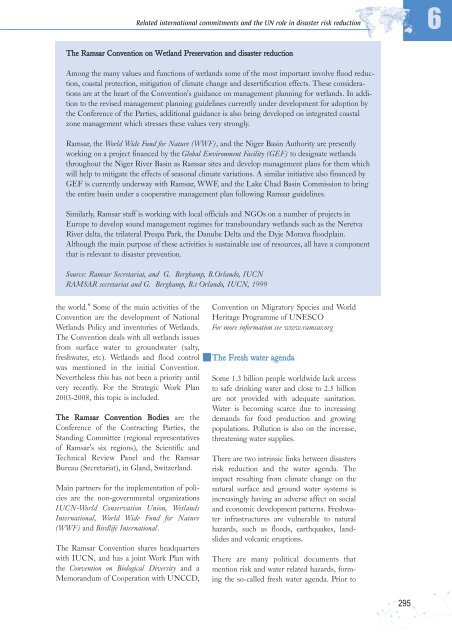A global review of disaster reduction initiatives - Welcome to the ...
A global review of disaster reduction initiatives - Welcome to the ...
A global review of disaster reduction initiatives - Welcome to the ...
You also want an ePaper? Increase the reach of your titles
YUMPU automatically turns print PDFs into web optimized ePapers that Google loves.
Related international commitments and <strong>the</strong> UN role in <strong>disaster</strong> risk <strong>reduction</strong>6The Ramsar Convention on Wetland Preservation and <strong>disaster</strong> <strong>reduction</strong>Among <strong>the</strong> many values and functions <strong>of</strong> wetlands some <strong>of</strong> <strong>the</strong> most important involve flood <strong>reduction</strong>,coastal protection, mitigation <strong>of</strong> climate change and desertification effects. These considerationsare at <strong>the</strong> heart <strong>of</strong> <strong>the</strong> Convention's guidance on management planning for wetlands. In addition<strong>to</strong> <strong>the</strong> revised management planning guidelines currently under development for adoption by<strong>the</strong> Conference <strong>of</strong> <strong>the</strong> Parties, additional guidance is also being developed on integrated coastalzone management which stresses <strong>the</strong>se values very strongly.Ramsar, <strong>the</strong> World Wide Fund for Nature (WWF), and <strong>the</strong> Niger Basin Authority are presentlyworking on a project financed by <strong>the</strong> Global Environment Facility (GEF) <strong>to</strong> designate wetlandsthroughout <strong>the</strong> Niger River Basin as Ramsar sites and develop management plans for <strong>the</strong>m whichwill help <strong>to</strong> mitigate <strong>the</strong> effects <strong>of</strong> seasonal climate variations. A similar initiative also financed byGEF is currently underway with Ramsar, WWF, and <strong>the</strong> Lake Chad Basin Commission <strong>to</strong> bring<strong>the</strong> entire basin under a cooperative management plan following Ramsar guidelines.Similarly, Ramsar staff is working with local <strong>of</strong>ficials and NGOs on a number <strong>of</strong> projects inEurope <strong>to</strong> develop sound management regimes for transboundary wetlands such as <strong>the</strong> NeretvaRiver delta, <strong>the</strong> trilateral Prespa Park, <strong>the</strong> Danube Delta and <strong>the</strong> Dyje Morava floodplain.Although <strong>the</strong> main purpose <strong>of</strong> <strong>the</strong>se activities is sustainable use <strong>of</strong> resources, all have a componentthat is relevant <strong>to</strong> <strong>disaster</strong> prevention.Source: Ramsar Secretariat, and G. Bergkamp, B.Orlando, IUCNRAMSAR secretariat and G. Bergkamp, B.t Orlando, IUCN, 1999<strong>the</strong> world." Some <strong>of</strong> <strong>the</strong> main activities <strong>of</strong> <strong>the</strong>Convention are <strong>the</strong> development <strong>of</strong> NationalWetlands Policy and inven<strong>to</strong>ries <strong>of</strong> Wetlands.The Convention deals with all wetlands issuesfrom surface water <strong>to</strong> groundwater (salty,freshwater, etc). Wetlands and flood controlwas mentioned in <strong>the</strong> initial Convention.Never<strong>the</strong>less this has not been a priority untilvery recently. For <strong>the</strong> Strategic Work Plan2003-2008, this <strong>to</strong>pic is included.The Ramsar Convention Bodies are <strong>the</strong>Conference <strong>of</strong> <strong>the</strong> Contracting Parties, <strong>the</strong>Standing Committee (regional representatives<strong>of</strong> Ramsar's six regions), <strong>the</strong> Scientific andTechnical Review Panel and <strong>the</strong> RamsarBureau (Secretariat), in Gland, Switzerland.Main partners for <strong>the</strong> implementation <strong>of</strong> policiesare <strong>the</strong> non-governmental organizationsIUCN-World Conservation Union, WetlandsInternational, World Wide Fund for Nature(WWF) and Birdlife International.The Ramsar Convention shares headquarterswith IUCN, and has a joint Work Plan with<strong>the</strong> Convention on Biological Diversity and aMemorandum <strong>of</strong> Cooperation with UNCCD,Convention on Migra<strong>to</strong>ry Species and WorldHeritage Programme <strong>of</strong> UNESCOFor more information see www.ramsar.orgThe Fresh water agendaSome 1.3 billion people worldwide lack access<strong>to</strong> safe drinking water and close <strong>to</strong> 2.5 billionare not provided with adequate sanitation.Water is becoming scarce due <strong>to</strong> increasingdemands for food production and growingpopulations. Pollution is also on <strong>the</strong> increase,threatening water supplies.There are two intrinsic links between <strong>disaster</strong>srisk <strong>reduction</strong> and <strong>the</strong> water agenda. Theimpact resulting from climate change on <strong>the</strong>natural surface and ground water systems isincreasingly having an adverse affect on socialand economic development patterns. Freshwaterinfrastructures are vulnerable <strong>to</strong> naturalhazards, such as floods, earthquakes, landslidesand volcanic eruptions.There are many political documents thatmention risk and water related hazards, forming<strong>the</strong> so-called fresh water agenda. Prior <strong>to</strong>295

















